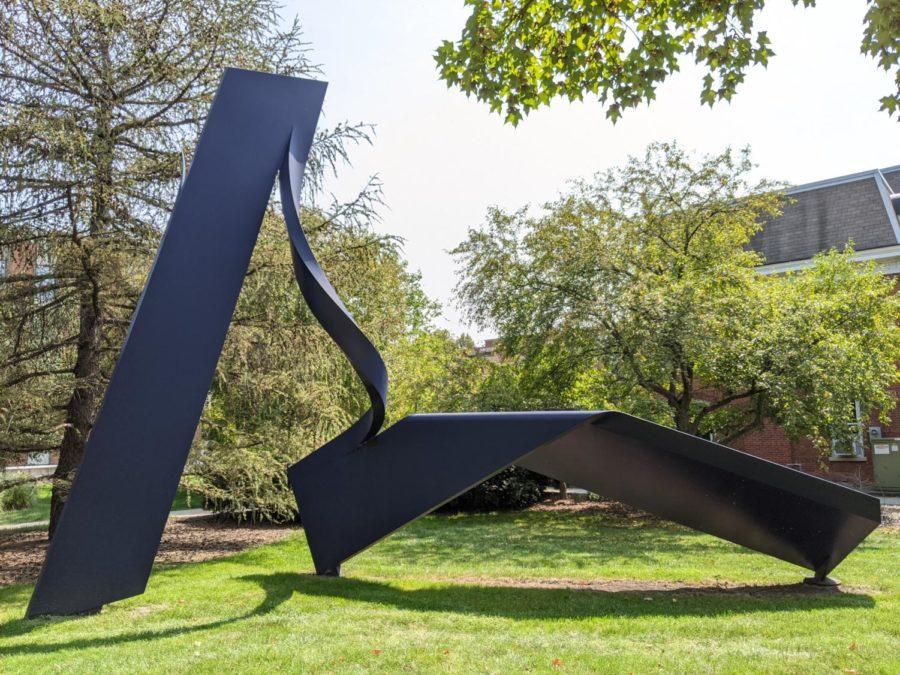Iowa State’s University Museums offer students opportunities to improve visual literacy
Carom Maquette, 1986 by Bruce White. Painted aluminum. Iowa Art in State Buildings project for Black Engineering. In the Art on Campus Preparatory Studies and Maquette Collection, University Museums, Iowa State University, Ames, Iowa.
September 9, 2021
Iowa State’s University Museums have long had a presence on campus, not only to add to the beautification of campus but to bring a new mode of literacy to students. The University Museums offer Visual Literacy programs and courses integrated into some courses at Iowa State to teach students the skills to come up with interpretations based on visual observation.
Visual literacy is all about understanding art as a form of communication, looking deeper into artistic pieces and finding new meanings and understandings. Director and Chief Curator for Iowa State’s University Museums Lynette Pohlman explained the programs and their purpose.
“When you take English you learn how to read symbols, letters and words, they have meaning and it’s accumulated knowledge that you gain from knowing the structure of words and language, that gives you insight into many areas,” Pohlman said. “So visual literacy helps you read a work of art just like you would read a paragraph.”
The ability to look in-depth at a work and come up with understandings and interpretations is a key aspect of critical thinking. Students practice these skills through mediums like writings and lectures, but practice with such critical thinking is often neglected in seemingly simple observations.
“80 percent of what you’ll learn if you are a sighted individual will be through visual interpretation, yet we don’t necessarily teach it,” Pohlman said. “What visual literacy does is help you with your communication skills as well as with your communication skills which are base core in all curriculums.”
To spread the gift of visual literacy, University Museums try to integrate their program into introductory courses like English 150. The programs walk students through three simple steps to read or make sense of a piece of art.
At first, students are asked to simply observe the piece, count objects, look into that background, etc., and take in all the information or data the piece offers. Next, students would use every detail from the piece and background information to come up with interpretations of the piece or find out what it’s trying to communicate to viewers. Finally, students would come up with evaluations of the piece, deciding what they think of it and what they may have taken from it.
Students’ ability to decrypt the meanings laid out by different artistic works is tied to their critical thinking skills. As students observe different aspects of such works, they practice using their critical thinking to connect what they see in an artistic piece to what they already know.
The applicability of visual literacy doesn’t end at admiring artistic works; rather, University Museums would have students practice their visual literacy on works of art, then exercise their skills in careers and life in general.
“I find some of the most visually literate, whether they’re taught that or not, are agronomists and plant breeders because their study is of not something that talks back to them,” Pohlman said. “They’re observing their plant or animal and their having to judge and interpret whats going on over time and hence they practice visual literacy a lot.”
Visual literacy not only allows for more in-depth observations and interpretations of the greater world but allows for greater insights stemming from the self.
“When you go to abstraction in a work of art it might be the viewer is looking, emotionally reflecting into it, which then is kind of like looking into your soul,” said Pohlman. “If you say it out loud it’s much more about the viewer than the artist who created it.”
Altogether visual literacy is a worthwhile skill to develop; luckily, for Iowa State students, the University Museums offers multiple venues for students to observe, interpret and evaluate works of art from a broad range of cultures and backgrounds.
Between the University’s three museums: Farm House Museum, the Christian Petersen Art Museum, and Brunnier Art Museum, the Anderson Sculpture garden and the art all over campus, students have a surplus of opportunities to sharpen their visual literacy. Taking advantage of these opportunities could lead to better clarity in complex issues and better understandings of day-to-day conundrums.







